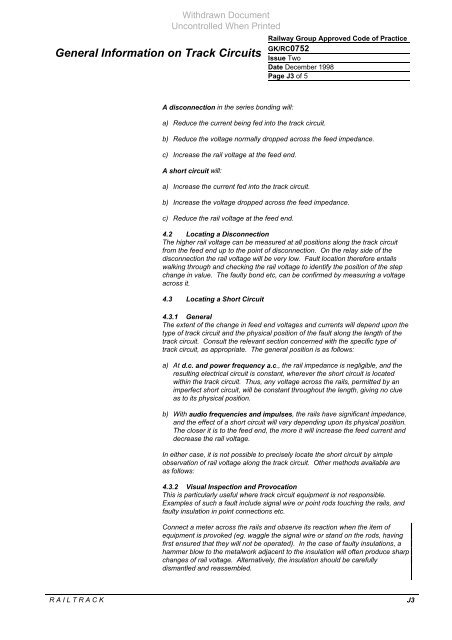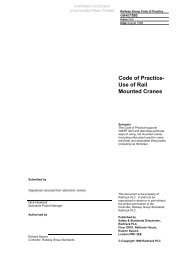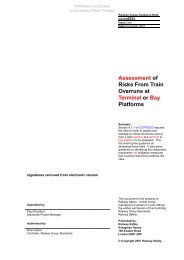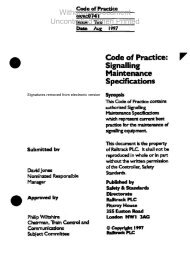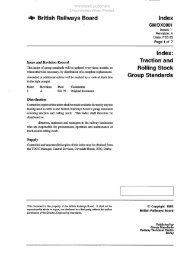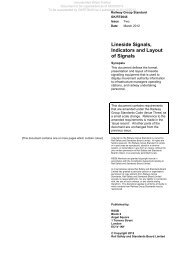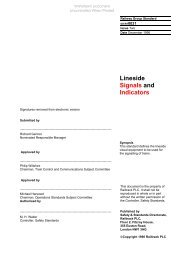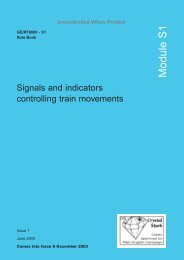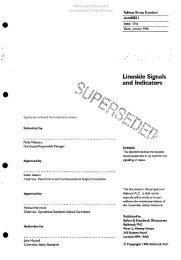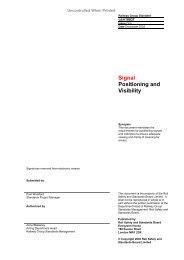General Information on Track Circuits - RGS Online
General Information on Track Circuits - RGS Online
General Information on Track Circuits - RGS Online
Create successful ePaper yourself
Turn your PDF publications into a flip-book with our unique Google optimized e-Paper software.
Withdrawn Document<br />
Unc<strong>on</strong>trolled When Printed<br />
<str<strong>on</strong>g>General</str<strong>on</strong>g> <str<strong>on</strong>g>Informati<strong>on</strong></str<strong>on</strong>g> <strong>on</strong> <strong>Track</strong> <strong>Circuits</strong><br />
A disc<strong>on</strong>necti<strong>on</strong> in the series b<strong>on</strong>ding will:<br />
a) Reduce the current being fed into the track circuit.<br />
Railway Group Approved Code of Practice<br />
GK/RC0752<br />
Issue Two<br />
Date December 1998<br />
Page J3 of 5<br />
b) Reduce the voltage normally dropped across the feed impedance.<br />
c) Increase the rail voltage at the feed end.<br />
A short circuit will:<br />
a) Increase the current fed into the track circuit.<br />
b) Increase the voltage dropped across the feed impedance.<br />
c) Reduce the rail voltage at the feed end.<br />
4.2 Locating a Disc<strong>on</strong>necti<strong>on</strong><br />
The higher rail voltage can be measured at all positi<strong>on</strong>s al<strong>on</strong>g the track circuit<br />
from the feed end up to the point of disc<strong>on</strong>necti<strong>on</strong>. On the relay side of the<br />
disc<strong>on</strong>necti<strong>on</strong> the rail voltage will be very low. Fault locati<strong>on</strong> therefore entails<br />
walking through and checking the rail voltage to identify the positi<strong>on</strong> of the step<br />
change in value. The faulty b<strong>on</strong>d etc, can be c<strong>on</strong>firmed by measuring a voltage<br />
across it.<br />
4.3 Locating a Short Circuit<br />
4.3.1 <str<strong>on</strong>g>General</str<strong>on</strong>g><br />
The extent of the change in feed end voltages and currents will depend up<strong>on</strong> the<br />
type of track circuit and the physical positi<strong>on</strong> of the fault al<strong>on</strong>g the length of the<br />
track circuit. C<strong>on</strong>sult the relevant secti<strong>on</strong> c<strong>on</strong>cerned with the specific type of<br />
track circuit, as appropriate. The general positi<strong>on</strong> is as follows:<br />
a) At d.c. and power frequency a.c., the rail impedance is negligible, and the<br />
resulting electrical circuit is c<strong>on</strong>stant, wherever the short circuit is located<br />
within the track circuit. Thus, any voltage across the rails, permitted by an<br />
imperfect short circuit, will be c<strong>on</strong>stant throughout the length, giving no clue<br />
as to its physical positi<strong>on</strong>.<br />
b) With audio frequencies and impulses, the rails have significant impedance,<br />
and the effect of a short circuit will vary depending up<strong>on</strong> its physical positi<strong>on</strong>.<br />
The closer it is to the feed end, the more it will increase the feed current and<br />
decrease the rail voltage.<br />
In either case, it is not possible to precisely locate the short circuit by simple<br />
observati<strong>on</strong> of rail voltage al<strong>on</strong>g the track circuit. Other methods available are<br />
as follows:<br />
4.3.2 Visual Inspecti<strong>on</strong> and Provocati<strong>on</strong><br />
This is particularly useful where track circuit equipment is not resp<strong>on</strong>sible.<br />
Examples of such a fault include signal wire or point rods touching the rails, and<br />
faulty insulati<strong>on</strong> in point c<strong>on</strong>necti<strong>on</strong>s etc.<br />
C<strong>on</strong>nect a meter across the rails and observe its reacti<strong>on</strong> when the item of<br />
equipment is provoked (eg. waggle the signal wire or stand <strong>on</strong> the rods, having<br />
first ensured that they will not be operated). In the case of faulty insulati<strong>on</strong>s, a<br />
hammer blow to the metalwork adjacent to the insulati<strong>on</strong> will often produce sharp<br />
changes of rail voltage. Alternatively, the insulati<strong>on</strong> should be carefully<br />
dismantled and reassembled.<br />
R A I L T R A C K J3


